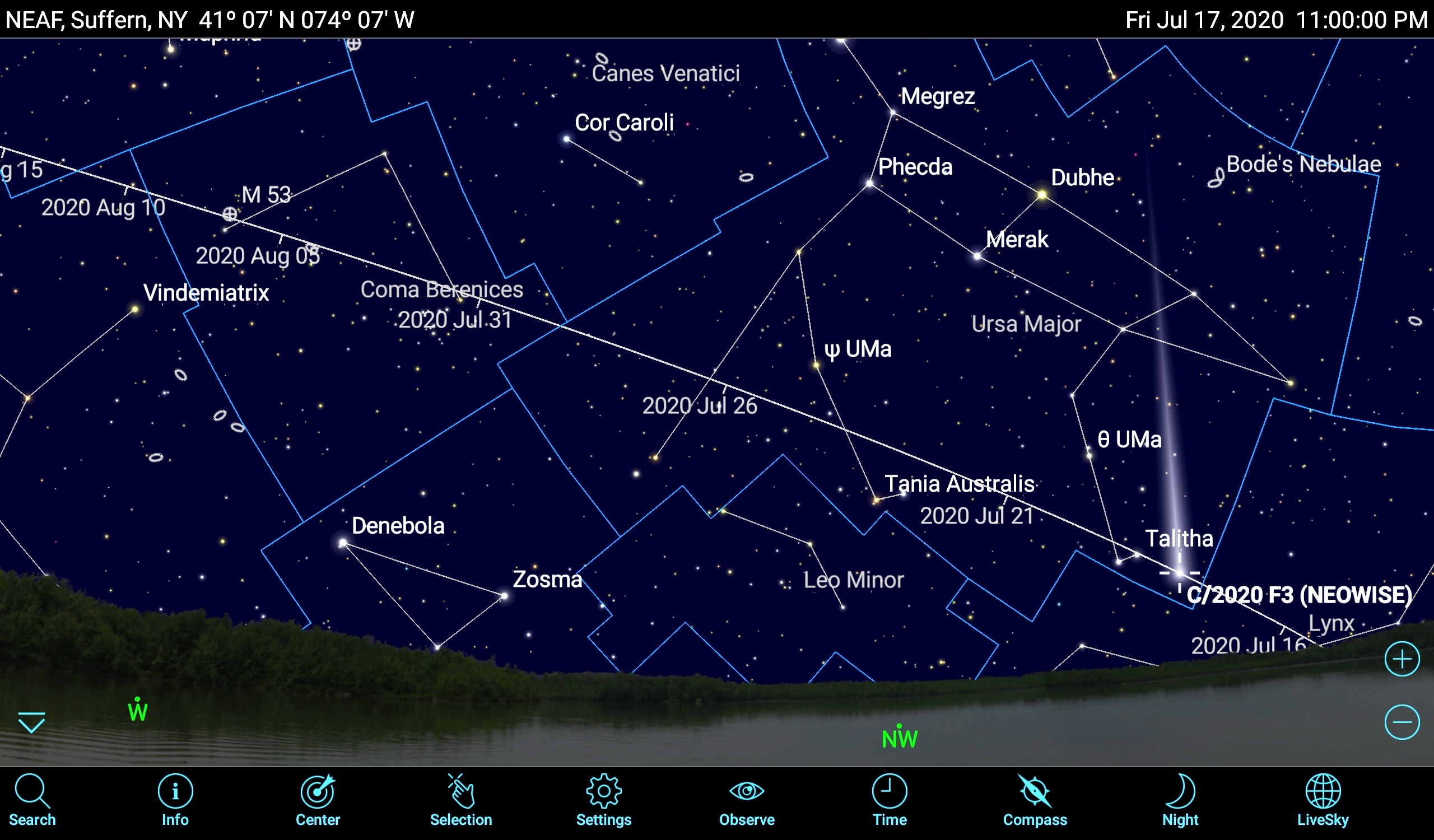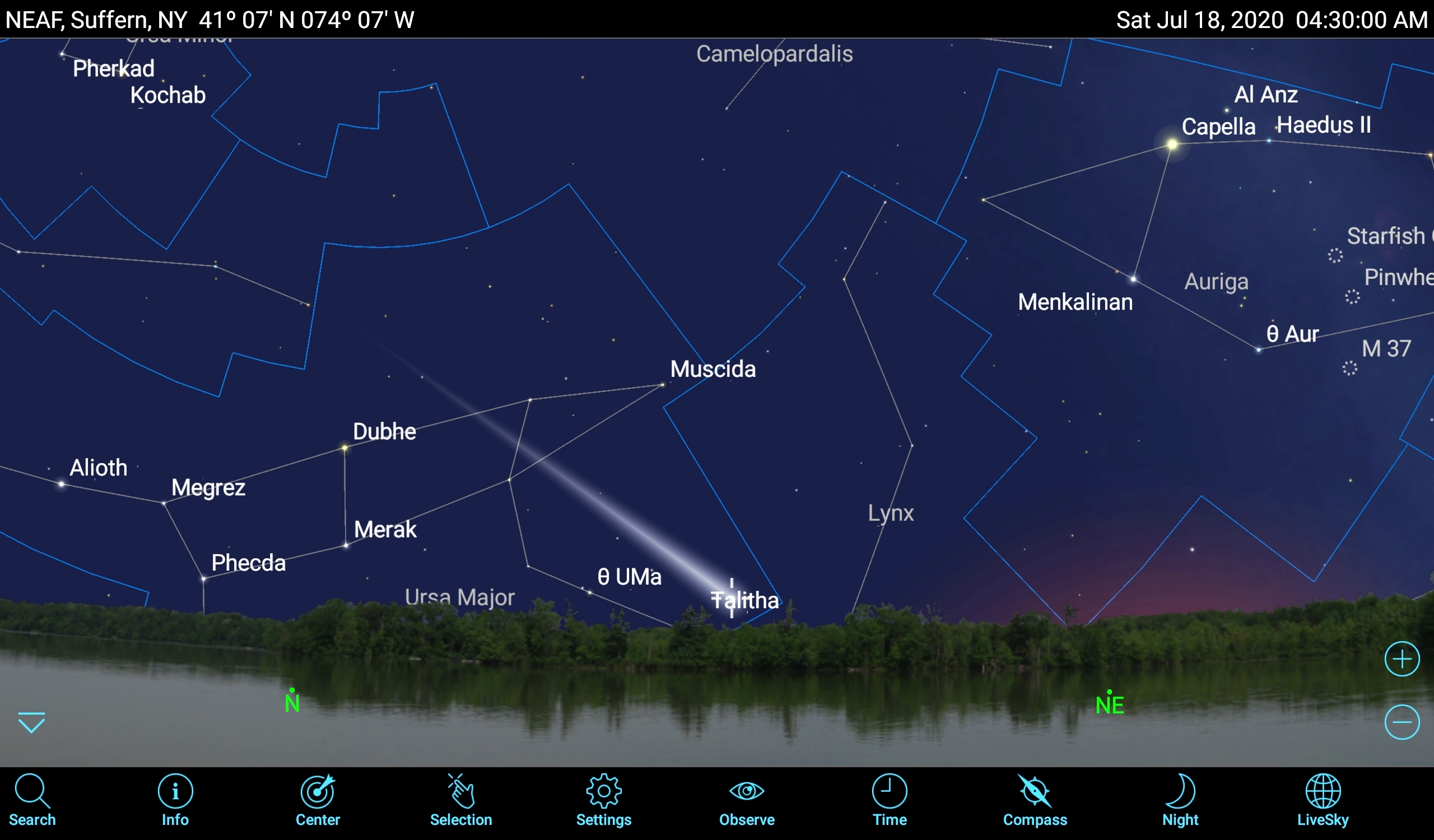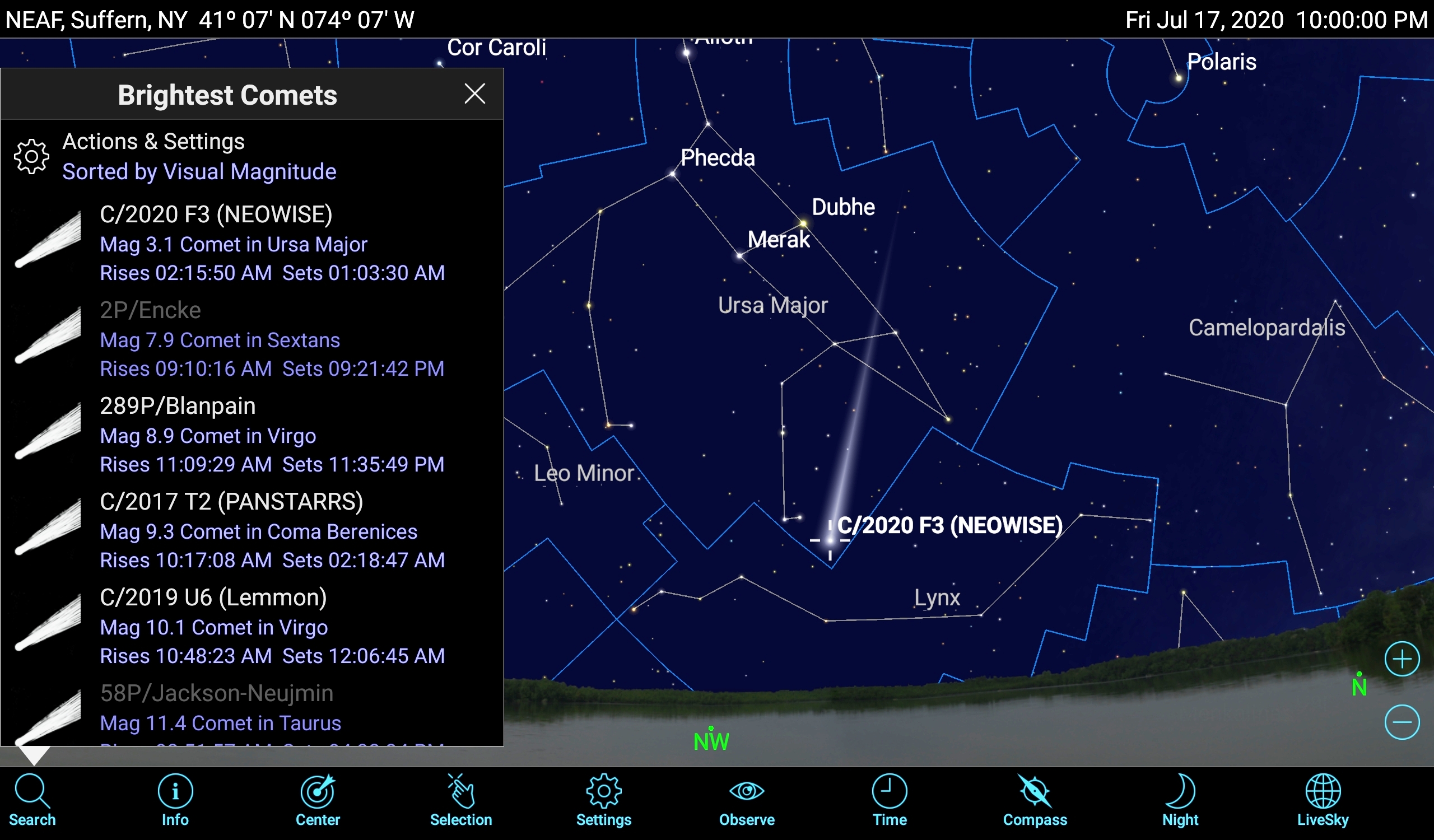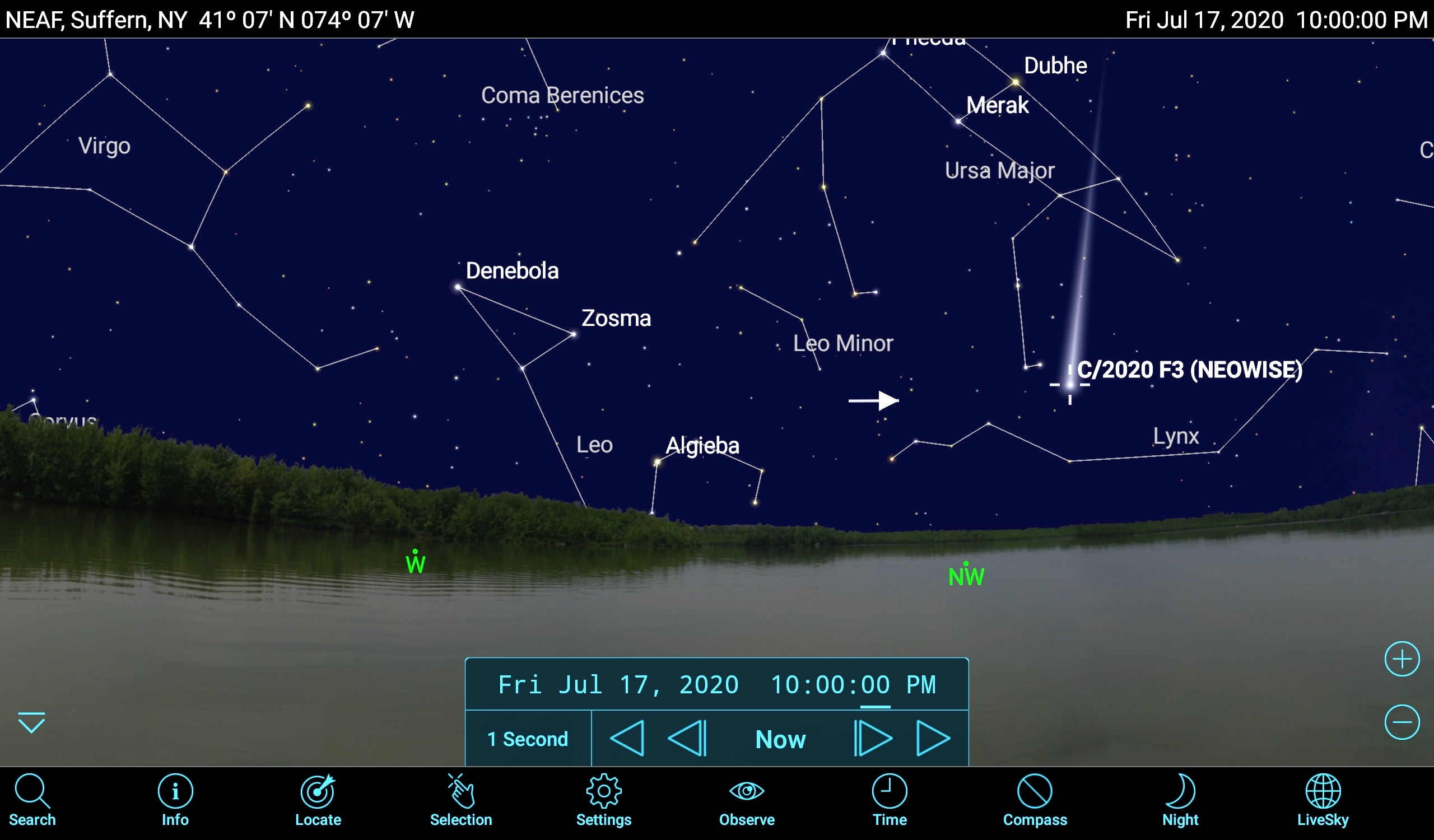How to spot the bright Comet NEOWISE using mobile apps
Skywatchers the world over are buzzing about Comet C/2020 F3 (NEOWISE), the first easily-visible comet to appear in years. Your favorite mobile astronomy app can tell you if the comet is visible from your location, and where and when to look for it.
To see the comet, you will need clear skies to the northwest, and a very low horizon that is free of obstructing trees and buildings. If you live in an apartment with western or north-facing windows or a balcony, you're in luck, too.
You can see this comet with your unaided eyes, but it will become truly spectacular through binoculars and telescopes. What you should expect to see is a small, bright, fuzzy spot, possibly with an orange or green hue.
Binoculars will reveal the comet's faint tail extending generally upwards, away from the sun. Actually, look for two tails pointed in slightly different directions — a brighter one composed of debris the comet is dropping behind it and a fainter, blue-tinted one composed of ionized gas. The latter tail will always point directly away from the sun, since it is being pushed by the solar wind. While your telescope will magnify the comet's head nicely, its tail will extend beyond your telescope's limited field of view.
Related: How to see Comet NEOWISE in the evening sky right now
More: Comet NEOWISE: 10 big questions (and answers) about the icy wanderer
How comet NEOWISE moves
As comets swing through the solar system, we see them move with respect to the background stars — night-to-night, and even hour-by-hour. This comet, which originated in the distant Oort cloud of icy bodies that envelopes our sun, dropped into the inner solar system from below (or south of) the plane of the planets' orbits. On July 3, it passed through that plane as it rounded the sun just outside the orbit of Mercury.
Now the comet is swinging upwards (north of that plane) while it flies away from the sun. That trajectory will bring the comet closest to the Earth (or perigee) on Wednesday (July 22) at approximately 9 p.m. EDT (0100 GMT on July 23), when it will be 64 million miles (103.5 million kilometers), or 0.692 astronomical units (1 AU is the average distance between Earth and the sun) away from us.
Breaking space news, the latest updates on rocket launches, skywatching events and more!
Unfortunately, as the comet nears Earth and looms larger, it will also be experiencing less heating from the sun, causing it to fade in visual brightness due to less gas production. It's a trade-off that makes looking at the comet at the first opportunity your safest bet.
From our point of view on Earth, the comet is heading in a northwesterly direction. The northerly component of that motion will cause the comet to become circumpolar for observers living north of about 41 degrees north latitude. That means it will never drop below the horizon, but it will sit too close to the horizon during the night — making it best visible only during the post-sunset and pre-dawn periods. Even better, that northerly motion will also lift the comet nearly a thumb's width (or 2 degrees) higher every night, making viewing much easier.
Where is comet NEOWISE
This week, the comet will be located generally below the Big Dipper in the northwestern sky during early evening — approximately two fist diameters below (or 23 degrees) southeast of the bright stars Dubhe and Merak, which form the bottom side of the dipper's bowl.
Once the sky darkens, the comet will become observable — generally after about 9:45 p.m. in your local time zone, depending on your latitude. At that time it will be positioned about 1.5 fist diameters (or 17 degrees) above the northwestern horizon, and descending to the right — towards the north. Once the sun has completely disappeared below the horizon, you can start to safely sweep the sky for the comet with your binoculars. By about 11 p.m. local time, the comet will become too low in the sky to see clearly.
You can use nearby naked-eye stars to help you find the comet. On July 22, when the comet will be closest to Earth, its path will carry it just above the rear paw stars of Ursa Major (the "big bear"), Tania Australis and Tania Borealis.
The comet will depart Ursa Major for the constellation Coma Berenices on July 29 — all the while diminishing in brightness. At some point, it will become too faint for naked-eye viewing, but should remain visible in binoculars and backyard telescopes.
For those who have better sight lines to the northeast, the comet will be visible in that direction before sunrise, although the comet will be lower than during evenings. The best views should occur around 4 a.m. local time. At that time, the comet will be positioned very low in the sky and climbing — this time, off to the right of Merak. Check the morning weather forecast before setting your alarm!
Using an app to find comet NEOWISE
Mobile apps like SkySafari 6 for iOS and Android can display comet NEOWISE's position in the sky at your location.
In SkySafari 6, tap the Search icon and select the Brightest Comets option. Look for the entry for Comet C/2020 F3 (NEOWISE) and tap it. (There are other comets named NEOWISE, so be sure to select the one that includes "F3".) The information page for the comet will tell you when it rises and sets at your location, and additional facts about it.
To display the comet's position in the sky using the app, tap the Center icon. To check on the comet's visibility where you live, tap the Time icon and set the app's time to 10 p.m. (If the comet becomes hidden behind the app's built-in horizon panorama, enter the Settings menu, choose Horizon and Sky, and set the Horizon Display option to Translucent Area.)
You can adjust the time and date to see where the comet will be in the future. If the comet disappears from the display, just use Search again. The app displays an enhanced representation of the comet's tail — to show you what direction it will be pointing.
If you are already outside with your device, you can use the app's Compass mode to show you where the comet is. Set the app to current time. Tap the Compass icon and then hold your device up to the sky and move it around until the comet is centered in the display. The real comet should now be in the sky in front of you.
It's a good idea to calibrate your device's compass and tilt sensors by turning your device over a few times in and moving it in a circular motion. You can check that it is pointing accurately by finding a bright star — or the bright planet Jupiter, which will sit over the southern horizon in evenings.
In compass mode, the SkySafari 6 toolbar will show a Locate icon. Tap that to summon an arrow that will tell which direction to move the device.
Good luck with your comet search. It's well worth making the effort to see this one. It may be some time before we have another bright visitor from the icy outer reaches of our solar system.
Editor's note: Chris Vaughan is an astronomy public outreach and education specialist at AstroGeo, a member of the Royal Astronomical Society of Canada, and an operator of the historic 74-inch (1.88-meter) David Dunlap Observatory telescope. You can reach him via email, and follow him on Twitter @astrogeoguy, as well as on Facebook and Tumblr.
Follow SkySafari on Twitter @SkySafariAstro. Follow us on Twitter @Spacedotcom and on Facebook.

Chris Vaughan, aka @astrogeoguy, is an award-winning astronomer and Earth scientist with Astrogeo.ca, based near Toronto, Canada. He is a member of the Royal Astronomical Society of Canada and hosts their Insider's Guide to the Galaxy webcasts on YouTube. An avid visual astronomer, Chris operates the historic 74˝ telescope at the David Dunlap Observatory. He frequently organizes local star parties and solar astronomy sessions, and regularly delivers presentations about astronomy and Earth and planetary science, to students and the public in his Digital Starlab portable planetarium. His weekly Astronomy Skylights blog at www.AstroGeo.ca is enjoyed by readers worldwide. He is a regular contributor to SkyNews magazine, writes the monthly Night Sky Calendar for Space.com in cooperation with Simulation Curriculum, the creators of Starry Night and SkySafari, and content for several popular astronomy apps. His book "110 Things to See with a Telescope", was released in 2021.






